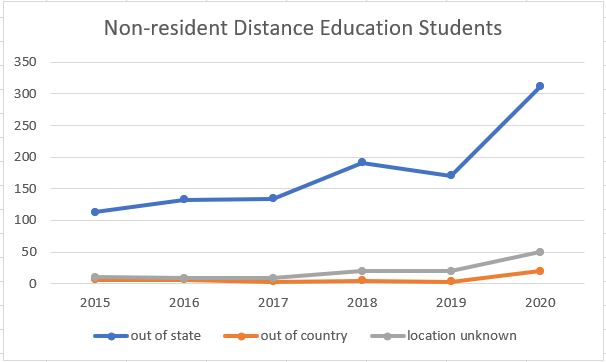A couple of days ago, I wrote about the effective decrease in instructional spending at WCC due to inflation. Since 2015, WCC’s spending on instruction has decreased (in constant 2015 dollars) by more than 12%. Instructional spending fell by double digits in all academic areas except for Math, Science and Health Sciences, where spending has only kept pace with inflation. Spending on one instructional line item, Distance Education, has increased by 34% during that time.
You might think that investments in distance learning are good. I’m not here to argue that point. The problem with WCC’s approach to distance education is that the Administration has priced it to attract students from outside of Washtenaw County.
I have written previously about Washtenaw County’s generous subsidy to out-of-district and out-of-state students. The WCC Administration has seen fit to extend tuition breaks to students who do not live or work in Washtenaw County. In fact, the data I looked at describes students who either live outside of Michigan, outside of the United States, or in an unknown place.
The graph below shows the growth in the number of these students between 2015 and 2020. (2020 is the last year for which these data have been reported.)

I want to be 100% clear. The WCC Administration has extended the use of the resources that Washtenaw County taxpayers built and paid for to people who do not live or work here and are unlikely to move here in the future. These are non-residents in every sense of the word. Yet, they pay tuition that is very similar to what you – a resident of Washtenaw County – would pay if you enrolled in a class either online or on campus.
Distance Education Should Not Be A Giveaway
It’s easy for the WCC Administration to give away the resources Washtenaw County residents have built to non-residents. The majority of the WCC executives are non- residents, and it costs them nothing to gift to others what does not belong to them.
The Eastern Gateway Community College Administration was all too eager to give away the resources that the residents of Jefferson County, OH built. I have a feeling that the WCC administration’s interest in Distance Education may have been inspired by EGCC’s explosive enrollment growth, thanks to its “free college for AFSCME members” business model. That is, before the Higher Learning Commission put the school on accreditation probation, and the Department of Education shut off the Pell Grant fire hose that funded it.
Like the WCC Administration, I would bet that the EGCC Administration and its Board of Trustees have no exit strategy for a distance education plan that now appears likely to leave the institution both unaccredited and bankrupt.
That’s not what the residents of Jefferson County had in mind when they funded EGCC, but they’re likely to be left picking up the pieces of a reckless administration and a careless Board of Trustees. Heavily subsidizing out-of-district, out-of-state, and out-of-country students is not what the residents of Washtenaw County had in mind when we funded WCC.
Washtenaw County taxpayers funded WCC for Washtenaw County residents. If non-residents want to attend WCC, that’s fine, but they should pay unsubsidized tuition. Accounting for the tax subsidies from Washtenaw County residents and the State of Michigan, WCC should be charging these non-resident distance education students about $250-$300 per credit hour. (Unless they would like to move here, which is also something the WCC executives should consider.)
Photo Credit: The Focal Project , via Flickr



























